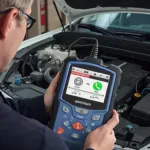The VW VR6 engine, known for its smooth power delivery and unique sound, has seen both OBD1 and OBD2 diagnostic systems. Understanding the key differences between VW VR6 OBD1 vs OBD2 is crucial for effective diagnostics and maintenance. This article dives deep into the nuances of each system, providing valuable insights for VR6 owners and enthusiasts.
Decoding the VR6’s Diagnostic Systems: OBD1 and OBD2
OBD, or On-Board Diagnostics, is a standardized system that monitors various aspects of your vehicle’s performance. The VW VR6 transitioned from OBD1 to OBD2 in the mid-1990s, marking a significant shift in diagnostic capabilities. While both systems aim to identify and report issues, they differ in their complexity, data access, and diagnostic tools. Choosing the right scanner for your VR6 depends on understanding these differences. obd1 vr6 vs obd2 vr6
OBD1: The Simpler System
OBD1 in the VR6 is relatively straightforward. It utilizes a simpler protocol and a limited number of diagnostic trouble codes (DTCs). This system primarily focuses on emissions-related components and relies on basic sensors and actuators. Retrieving codes often involves using a jumper wire or a basic code reader.
OBD2: Enhanced Diagnostics
OBD2 brought significant advancements to vehicle diagnostics. It uses a standardized 16-pin connector, providing access to a wider range of data and more comprehensive DTCs. This allows for more precise identification of issues, including those related to engine performance, transmission, and other critical systems.
Why the Change from OBD1 to OBD2?
The shift to OBD2 was driven by environmental regulations and the need for more sophisticated diagnostics. OBD2 offers improved monitoring of emissions-related components, contributing to cleaner air. Its enhanced data access allows for quicker and more accurate troubleshooting, leading to more efficient repairs.
Key Differences: OBD1 vs OBD2 in the VR6
- Connector: OBD1 uses a variety of connectors depending on the model year, while OBD2 uses a standardized 16-pin connector.
- Data Access: OBD2 provides access to significantly more data than OBD1, allowing for more comprehensive diagnostics.
- DTCs: OBD2 offers a broader range of DTCs, allowing for more specific identification of issues.
- Diagnostic Tools: OBD2 requires more advanced scan tools capable of interpreting the complex data stream.
- Emissions Monitoring: OBD2 features enhanced emissions monitoring capabilities, ensuring compliance with regulations.
Choosing the Right OBD Scanner for your VW VR6
Selecting the appropriate OBD scanner for your VR6 is essential. For OBD1 VR6s, a basic code reader may suffice. However, for OBD2 VR6s, a more advanced scan tool is necessary to fully utilize the system’s capabilities. These tools provide access to live data, allowing for real-time monitoring of various parameters.
“Choosing the right scanner can save you time and money in the long run,” says renowned automotive diagnostician, Dr. Emily Carter. “Investing in a quality OBD2 scanner empowers you to take control of your VR6’s maintenance and avoid unnecessary trips to the mechanic.”
Common Troubleshooting Scenarios with a VW VR6
- Check Engine Light: Both OBD1 and OBD2 systems utilize the Check Engine Light to alert the driver of potential issues.
- Misfires: Diagnostic tools can pinpoint misfires and help identify the underlying cause, whether it’s a faulty spark plug, ignition coil, or fuel injector.
- Emissions Issues: OBD systems are crucial for diagnosing emissions-related problems, such as faulty oxygen sensors or catalytic converters.
Conclusion: Navigating the World of VR6 OBD Systems
Understanding the distinctions between VW VR6 OBD1 vs OBD2 is paramount for effective vehicle maintenance. By choosing the right diagnostic tools and interpreting the data correctly, you can ensure the longevity and optimal performance of your VR6 engine. Remember, a properly functioning OBD system is your key to a smooth and reliable driving experience.
FAQs:
- What year did VW VR6 switch to OBD2? Generally, VW VR6 engines transitioned to OBD2 in 1996.
- Can I use an OBD2 scanner on an OBD1 VR6? No, you need a specific OBD1 code reader or adapter.
- Where is the OBD2 port located on a VW VR6? Typically, it’s under the dashboard on the driver’s side.
- What does a flashing Check Engine Light indicate? It signals a serious problem requiring immediate attention.
- Can I clear DTCs myself? Yes, with an OBD scanner, but addressing the underlying issue is crucial.
- What are some common OBD2 codes for VR6 engines? Common codes relate to misfires, oxygen sensors, and evaporative emissions.
- Why is my OBD scanner not connecting to my VR6? Check the connection, fuse, and ensure compatibility.
“Regularly scanning your VR6 with the appropriate OBD tool is like giving your engine a regular health check,” advises automotive expert, Michael Johnson. “Early detection and diagnosis can prevent small problems from escalating into major and costly repairs.”
Need help? Contact us on WhatsApp: +1(641)206-8880, Email: [email protected]. We have a 24/7 customer support team.


